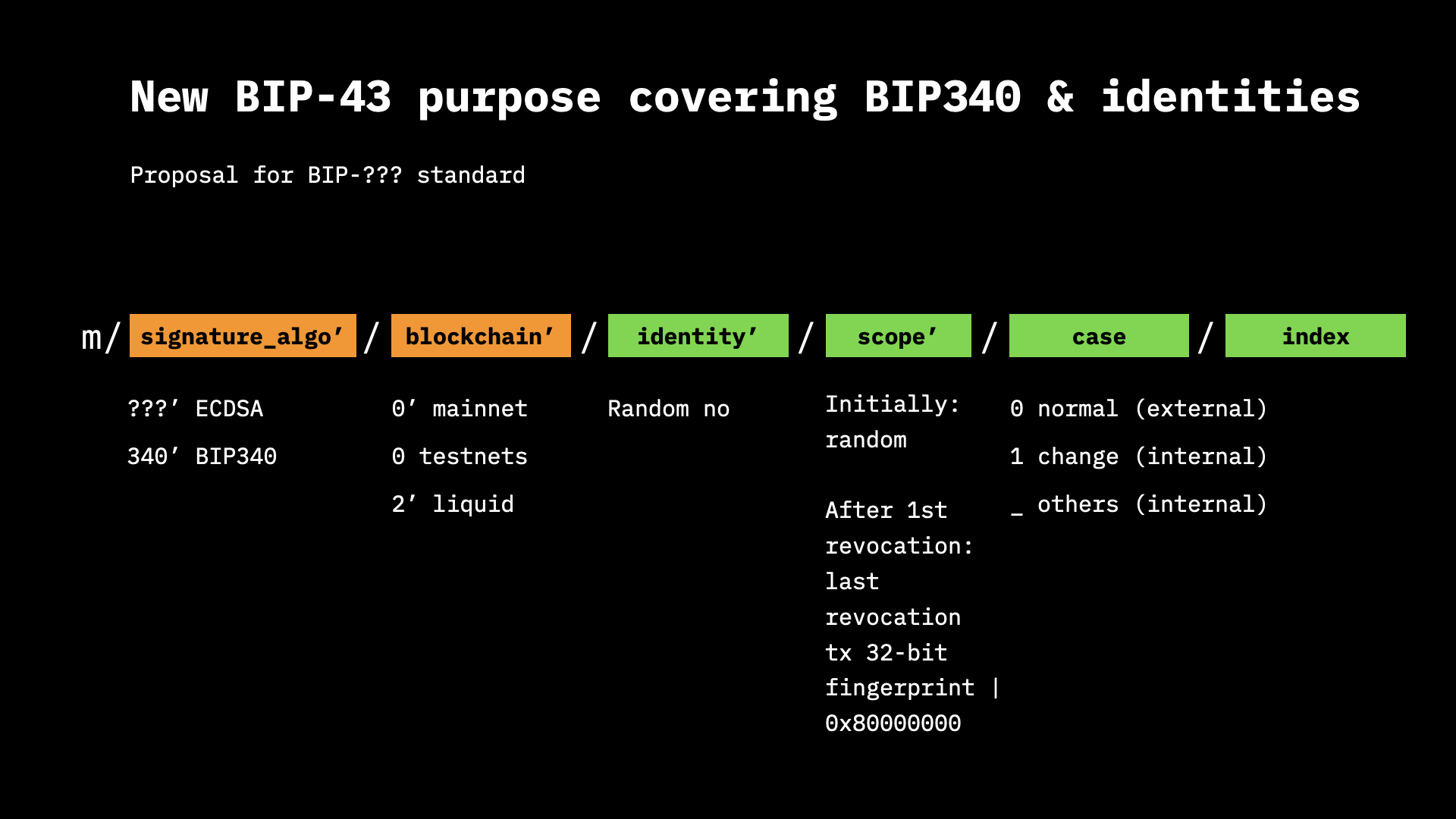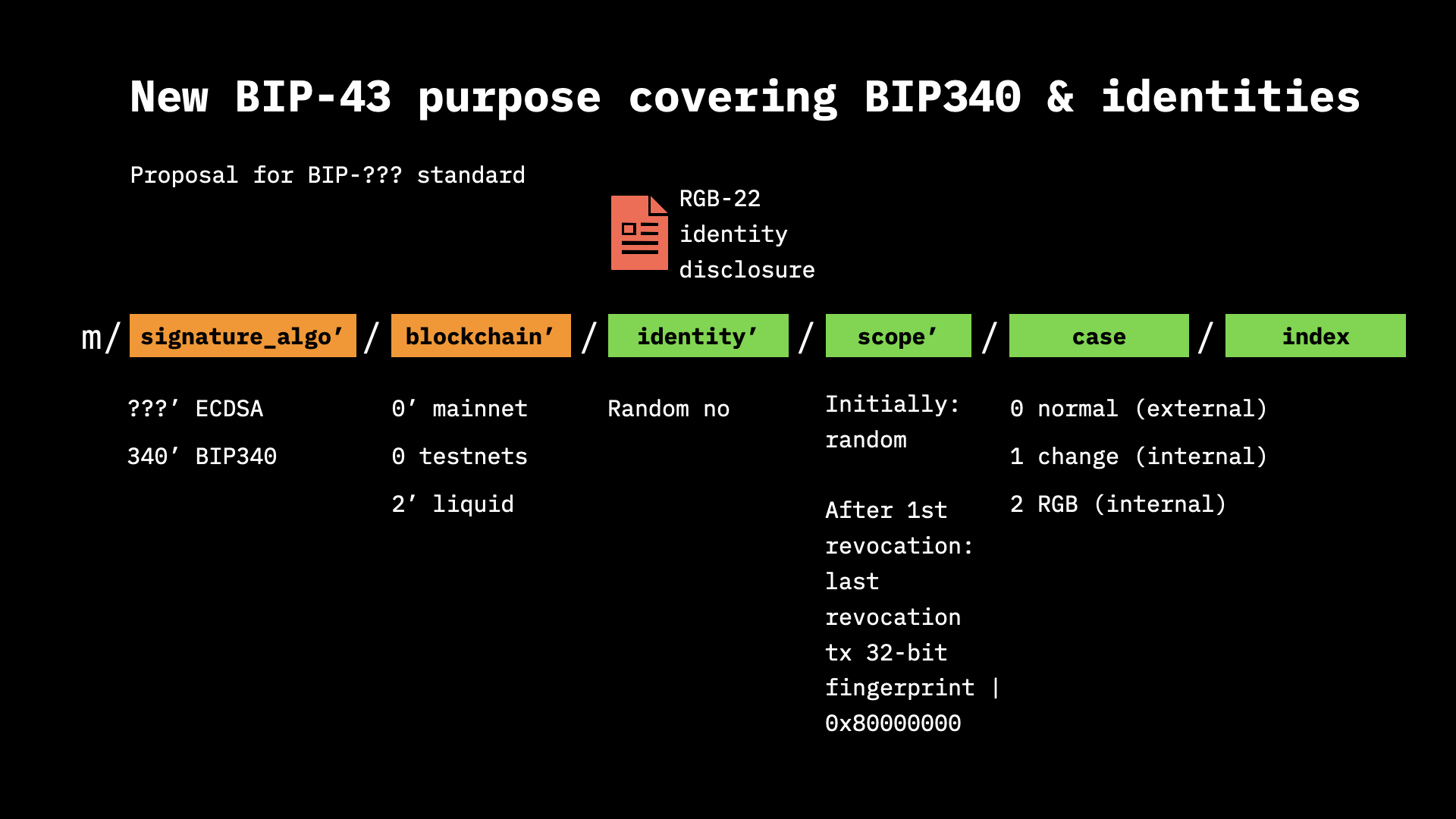BIP32-based decentralized identity #87
dr-orlovsky
started this conversation in
Proposals
Replies: 0 comments
Sign up for free
to join this conversation on GitHub.
Already have an account?
Sign in to comment
-
Background
Had a discussion last night in Bitcoin Core IRC with Peter Wuille on different topics regarding key derivations, security, key tweaks in context of Schnorr signatures & Taproot. Would like to share some action points and plans that emerged from there:
There is a real need for BIP-43 based new BIP with a new purpose field for keys used in Schnorr signatures. Peter will not do it (he is not very much interested in spending his time on wallet-level stuff), so someone else should.
Keys used in Schnorr signatures MUST NEVER BE used in ECDSA signatures, otherwise there is a risk of private key leak via correlation attack. This is rationale behind N1.
The other need (not discussed with Peter) is to change the general structure of derivation path used before with BIP-44, 45, 84. This change is required to enable the use of all modern wallet use cases under a single standard: single-sigs & multi-sigs, ECDSA & BIP340 signatures.
Embedding multisig support in a hierarchical format requires introduction of a “signer id” concept as a part of the derivation path. I found a way how this can be done seamlessly, leading to emergence of decentralized identity as a side effect.
Proposal
Derivation path structure & purpose values
The new format for the hierarchical derivation BIP32 path is the following:
Purpose:
BIP-43 purpose values under the proposal:
Thus, purpose will be used to signify the type of the signature.
NB: purpose MUST be hardened since otherwise a key leak may occur.
Blockchain:
was not there before, but now we should have it:
Testnet path
1covers all testnets (no problem with key re-use for valueless testnet or inter-testnet chainanalysis) - this follows the logic of recent changes in other standards related to testnet (use the same Bech32 prefixes for all testnets).Testnet path is unhardened from this point & till the end of the derivation path: no need to prevent private key leak there, simplifies test software (hardened paths require private key access for derivation).
Devs are free to choose other unhardened number if they need, without changing the standard - unhardened numbers will never be used for chains with real value.
Identity and scope
Hardened components signify the main identity (decentralized id) and the scope under that id used in context of specific multisig wallet or other identity case. Scope is required to use the same id with different peers without exposing the main identity xpub (and, thus, the scope must be hardened as well).
Case
This is the same as a “change” field before (under BIP44 etc), however it is proposed to change the name to denote that the field may have other values and is used for signalling support for some custom features (for instance, pay-to-contract or sign-to-contract schemes, which may be used for client-side validation like in RGB protocol etc).
Index
Sequentially increased index like in BIP44
Identity basics
Identity index SHOULD be a random number within BIP32 hardened index range.
Rationale: derivation path may be kept public (see decentralized logins below), and use of sequential numbers will leak information of how many identities are used by some person.
(Identity) scope index: depending on whether revocation is enabled:
Rationale for identity scope: it is required for an identity to be safely usable under multiple multisig wallets/descriptors without exposure of the identity xpub to unrelated parties. Its introduction also allows to use the keys derived under the same identity index as a universal decentralized identity (see details below) without the risk of correlation analyses; especially when they are used outside of the transaction context (for instance as a part of login) without the risk of chain analysis against such data (linking logins to onchain transactions).
Identity representations
The XpubIdentifier created with extended public key under BIP32 derivation path ending at the level of the identity index is called bitcoin decentralized id (hereinafter simply decentralized id).
Rationale: XpubIdentifier is a hash of the extended public key, thus id does not leak any confidential information about the user, her/his outputs or any keys used in the setup and after. As a 256-bit number it is sufficient for global unique identification; and it is created in such a way that it will always be unique for each user (based on the selection of random number), seed & derivation path combination; which allows each user to have multiple unique decentralized ids without any significant risk collision. These ids will be scoped to some blockchain & authorization scheme (based on the use of specific signature algorithm).
Decentralized id can be used as a unique user login or a key for searching user metadata with different centralized or decentralized systems, which design is outside of the scope of this proposal (however there is a WIP in this regard involving client-validated LN-based smart contract system).
Aside from the decentralized id, when a user needs to use the identity under some scope (i.e. creating multisig wallet or registering/signing up to some online service or an app) he should use the following string, called “decentralized login” and/or “decentralized id string":
Where:
bcid;Rationale on the use of Bech32m encoding for XpubIdentifier
bcidHRP is selected to signify that this particular id standard is based on bitcoin ecosystem and Secp256k1 curves.Rationale on login string:
NB: If the revocation protocol is supported this string MUST be suffixed with a revocation single-use-seal (see below) in form of
?txid:voutExamples:
Decentralized id: bcid1ncr68x65lpvpz8nqtjrchnheru2e5x9rcdf2dk (this id corresponds to XpubIdentifier 9e07a39b54f858111e605c878bcef91f159a18a3; since I do not have Bech32m at hand I have temporally used Bech32)
Decentralized login: m/340’/0'/[bcid1ncr68x65lpvpz8nqtjrchnheru2e5x9rcdf2dk]/20721421274’=[xpub6FHa3pjLCk84BayeJxFW2SP4XRrFd1JYnxeLeU8EqN3vDfZmbqBqaGJAyiLjTAwm6ZLRQUMv1ZACTj37sR62cfN7fe5JnJ7dh8zL4fiyLHV]
Decentralized login with key revocation: m/340’/0'/[bcid1ncr68x65lpvpz8nqtjrchnheru2e5x9rcdf2dk]/20721421274’=[xpub6FHa3pjLCk84BayeJxFW2SP4XRrFd1JYnxeLeU8EqN3vDfZmbqBqaGJAyiLjTAwm6ZLRQUMv1ZACTj37sR62cfN7fe5JnJ7dh8zL4fiyLHV]?0e94ada127fbbc6d2152b18a50fd02ea9aaa608ec20cfc606ad327da1c255201:1
Multisig wallets with decentralized id
In case of multisig wallet creation, the parties may share their decentralized id strings in one of two forms:
This will provide all parties with a sufficient information to construct full paths with a sequentally-increased final indexes
for change and normal cases.
The first option will allow all parties to prepare PSBTs for the common signing process; however they will not be able to generate invoices or track blockchain for new transactions. However, on the other hand, that will not leak the scoped xpub.
The second option allows full features for multisig wallets, including invoice creating and onchain tracking.
Authenticating with decentralized id
To authenticate (or register) a user must provide the authentification service with the following information:
Login string from the previous section
Random number within the unhardened BIP32 index range
A signature, created according to the signature algorithm specified as a part of login (ECDSA or BIP340) with the private key derived with the following derivation path:
m/purpose’/blockchain'/identity’/scope’/random_seed
where random_seed is the random number from the above.
This scheme is non-interactive and can be used for authentication, authorization and registration with servers or applications.
Rationale:
Identity revocations
It will be possible to revoke identities using single-use-seals mechanics ([originally proposed by Peter Todd][1]) based on bitcoin blockchain. What's important here is that this will not lead to the increase in transaction size and may be simply combined with normally happening transactions using special signature design procedure (see below).
NB: Since the revocation procedure is non-trivial, it is proposed to have the first version of the standard to be published without it and add it later by using the suffix
?txid:voutwith the revocation single-use-seal added to the identity string.The protocol runs as follows:
Identity creation
Alice, after creating a decentralized identity under this standard and its first scope, chooses some of her existing bitcoin UTXOs and uses it as a suffix for the identity/login string. It is important that:
Identity scope revocation
If Alice needs to revoke specific scoped identity xpub (for instance, a private key leak happened) she needs to:
kused during the signature creation to01value.Full identity revocation
Alice also has an option of completely revoking the identity without providing a new scope, which will be an equivalent of removing login or cancelling participation in a multisig wallet. To do so she just needs to set two most significant bits to
10value instead of01.Identity revocation detection
Other parties knowing Alice's identity string (her multisig co-signers under the same identity scope or services that her login information is) will know about revocation by monitoring the spending of the revocation UTXO in the blockchain and checking firts two most significant bit values in
kvalue computable from the the signature in the spending input. They will be able to monitor consequent revocations using the first output from the revocation transaction as a new single-use-seal. They will also update Alice’s identity scope accordingly and will be able to verify Alice’s new signatures without any communications with her. It’s quite important that they will also be able to decline Alice's login attempts with the revoked key from the moment the revocation tx got into mempool, i.e. instantly.Spending single-use-seal without revocation
If, because of whatever reason, Alice needs to spend the UTXO which was previously marked as a revocation UTXO without the actual revocation, she can do that by setting ‘k’ two most significant bits to
00value. The new revocation UTXO will become assigned to the first input of that transaction, but the identity would not be revoked and the scope value will not change.Visual summaries
I have prepared some visual summaries covering the proposal, which may simplify its analysis:
Before RGB:

With RGB:

Beta Was this translation helpful? Give feedback.
All reactions